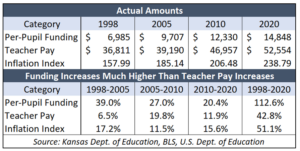The Kansas Association of School Boards (KASB) is a membership group funded by local school districts, so it was quite surprising to see them criticize their members recently for low teacher pay. The column written by Mark Tallman didn’t chastise members, of course, but KASB and their members know that the blame for teacher pay is theirs alone. Tallman’s column is intended to blame legislators and taxpayers for giving school districts a measly $1 billion increase (they wanted $2 billion), pointing out that teacher pay hasn’t kept up with inflation.
The inflation part is true, but KASB didn’t mention that legislators don’t determine teacher pay. As Speaker of the House Ron Ryckman says, “Once the funding reaches the school district, it’s up to their local school boards to decide how it’s spent.”
And their decisions are not driven by lack of funding, as KASB wants taxpayers and teachers to believe.
 Average teacher pay in Kansas was $36,811 in 1998, according to the U.S. Department of Education’s National Center for Education Statistics, In 2005, average pay was $39,190 or 6.5% more than in 1998. At the same time, per-student school funding increased by 39%, from $6,985 (adjusted for KPERS) to $9,707 while the inflation index jumped 17.2%. KASB and their school board members cannot blame lack of money for teacher pay not keeping up with inflation.
Average teacher pay in Kansas was $36,811 in 1998, according to the U.S. Department of Education’s National Center for Education Statistics, In 2005, average pay was $39,190 or 6.5% more than in 1998. At the same time, per-student school funding increased by 39%, from $6,985 (adjusted for KPERS) to $9,707 while the inflation index jumped 17.2%. KASB and their school board members cannot blame lack of money for teacher pay not keeping up with inflation.
The Kansas Supreme Court ordered a $775 million funding increase starting in 2006, and the Legislature passed a policy calling on schools to devote that money to Instruction; the goal was to eventually have 65% of all spending going to Instruction. School boards got the money but they ignored legislative intent.
Between 2005 and 2010, per-student funding increased 27% but teacher pay was just 19.8% higher. Funding jumped 20.4% over the next ten years, topping out at $14,848 per student but teacher pay increased 11.9%.
School districts mislead teachers on funding
Teachers and other frontline workers continually ask legislators to increase funding so they can get pay increases.
Molly Baumgardner, chair of the Senate Education Committee, says teachers often say district administrators tell them they can’t raise pay because the Legislature isn’t adequately funding schools. That’s not true, of course; it’s just administrators using teachers as pawns to get more money (mostly, for other stuff).
For the record, the Kansas Supreme Court declared school funding adequate more than three years ago. But even prior, districts had multiple options to raise teacher pay.
- They could dip into carryover cash reserves, which sat at nearly $1 billion at the start of this school year.
- Local school boards and administrators barely allocate half of all funding to Instruction, and they are totally in charge of the allocation. Funding increased by $2.8 billion between 2005 and 2020, but only $1.4 billion went to Instruction.
- A lot of that other $1.4 billion went to hiring more non-Instructional staff. Enrollment and the number of classroom teachers increased by 8% between 2005 and 2020, but school boards hired 16% more managers and 19% more people in other non-instructional positions.
By the way, school superintendents hold the top four spots on the list KPERS ‘millionaires’ – people who will collect more than $1 million in pension benefits over their first 20 years of retirement. Those four will collectively receive over $15 million over 20 years.
Baumgardner says schools have had large funding increases over the last two years that easily set new records, but school administrators aren’t giving teachers accurate information.
“Over the last five years, Senate Education constantly heard requests from teachers for pay increases. We always remind them that local school boards make those decisions, not legislators.”
Speaker of the House Ron Ryckman says House members are also frustrated at how districts allocate money.
“While the Legislature continues to increase funding for our K-12 schools, our teachers are not being given their fair share of it. But I know legislators on both sides of the aisle would like to see more of that money focused on teacher pay and reach the classroom.”
Needs assessment should identify appropriate teacher pay
School districts are supposed to conduct annual building needs assessments and use the results to inform the budget process. There is little evidence of that taking place, however, so the Legislature took additional action this year.
Former Speaker of the House Mike O’Neal says the new provision will at least prevent schools from claiming they lack sufficient funding to educate students.
“Current law already requires local school boards to approve budgets based on a required school-by-school needs assessment which includes, among other things, whether classrooms have qualified teachers in place and whether teacher pay is appropriate. The Legislature added to that law this year by requiring that these school board-approved budgets be reasonably calculated to have all students meeting educational goals. The largest component of the Instruction category is teacher pay. If the Instruction function is not operating at an acceptable level, the whole educational program is doomed to failure regardless of how well the other functions perform. That’s a direct quote from the Kansas State Department of Education Accounting Handbook.”
State assessment results certainly support that ‘doomed to failure’ concern, as there are more high school students below grade level in Kansas than are on track for college and career.
It seems that that old saying about death and taxes being the only sure things in life should be amended. It’s a sure bet that school districts will never be satisfied with funding and they won’t be straight with teachers and parents about funding and achievement.




